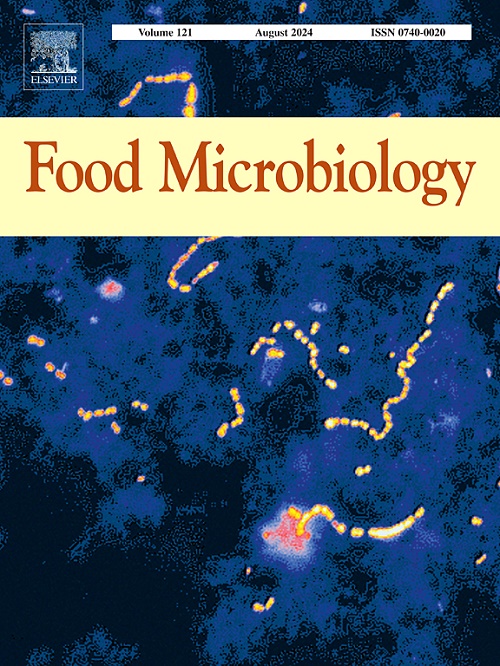Commercial bacteriophage preparations for the control of Listeria monocytogenes and Shiga toxin-producing Escherichia coli in raw and pasteurized milk
IF 4.6
1区 农林科学
Q1 BIOTECHNOLOGY & APPLIED MICROBIOLOGY
引用次数: 0
Abstract
Listeria monocytogenes was the etiologic agent in nearly all recent outbreaks in North America attributed to pasteurized dairy products, whereas Escherichia coli O157 infections were responsible for most of the rare, yet serious complications from outbreaks involving unpasteurized dairy. This study determined the susceptibility of selected strains of L. monocytogenes and Shiga toxin-producing E. coli (STEC) to commercial phage preparations and their ability to control these pathogens in pasteurized and raw milk during 7-day storage at 7 °C. Both phage products demonstrated high lytic efficiency against 17 strains of L. monocytogenes whereas the efficiency of E. coli phages was more variable against 11 strains of O157 and non-O157 STEC. Broth microdilution assays identified effective endpoint multiplicities of infection (MOI) ranging from log 2.53 to 5.13, which differed between strains of L. monocytogenes and phage products. Mean log MOIs of E. coli phages against STEC also varied within and between products from 0.43 to 7.05. Despite these observations, the change in counts over time of three L. monocytogenes strains exposed to phage in pasteurized milk (log MOI 6) was similar with counts ∼ 4 log CFU/mL lower than control at day 7. Results for STEC O157 varied by strain but counts were lower than control in all cases by 72 h thorough day 7. Titers on isolates of both pathogens isolated from pasteurized milk indicated that the surviving populations were less susceptible to phage. The addition of a phage preparation to raw milk did not reduce populations of either pathogen or affect the change in counts of any strain over time when compared to control. Reduced efficacy in raw milk may be attributed to reduced phage binding as titers in raw milk decreased steadily (∼2 log PFU/mL) during storage. Commercial phage products may be a promising pathogen control intervention for pasteurized dairy products, warranting further investigation.
用于控制生奶和巴氏杀菌奶中李斯特菌和产志贺毒素大肠杆菌的商用噬菌体制剂
单核细胞增生李斯特菌是近期在北美爆发的几乎所有巴氏杀菌乳制品疾病的病原体,而大肠杆菌 O157 感染则是涉及未经巴氏杀菌乳制品的罕见但严重并发症的罪魁祸首。本研究确定了单核细胞增多性嗜酸乳杆菌和产志贺毒素大肠杆菌(STEC)对商用噬菌体制剂的敏感性,以及它们在 7 °C 下储存 7 天期间控制巴氏杀菌乳和生乳中这些病原体的能力。两种噬菌体产品对 17 株单核细胞增多性嗜酸乳杆菌的溶解效率都很高,而大肠杆菌噬菌体对 11 株 O157 和非 O157 STEC 的溶解效率差异较大。肉汤微量稀释测定确定的有效终点感染倍数(MOI)从对数 2.53 到 5.13 不等,单核细胞增多性酵母菌株和噬菌体产品之间存在差异。大肠杆菌噬菌体对 STEC 的平均对数 MOI 也因产品而异,从 0.43 到 7.05 不等。尽管有这些观察结果,但在巴氏杀菌奶(对数 MOI 6)中暴露于噬菌体的三种单核细胞增多症菌株的计数随时间的变化是相似的,第 7 天时的计数比对照组低 4 log CFU/mL。STEC O157 的结果因菌株而异,但在第 7 天后的 72 小时内,所有菌株的计数均低于对照组。从巴氏杀菌牛奶中分离出的两种病原体的滴定结果表明,存活的菌群对噬菌体的敏感性较低。与对照组相比,在生牛奶中添加噬菌体制剂不会减少两种病原体的数量,也不会影响任何菌株数量随时间的变化。生牛奶中噬菌体的效力降低可能是由于噬菌体的结合力降低所致,因为在储存过程中,生牛奶中噬菌体的滴度持续下降(PFU/mL ∼ 2 log)。商业噬菌体产品可能是巴氏杀菌乳制品中一种很有前景的病原体控制干预措施,值得进一步研究。
本文章由计算机程序翻译,如有差异,请以英文原文为准。
求助全文
约1分钟内获得全文
求助全文
来源期刊

Food microbiology
工程技术-生物工程与应用微生物
CiteScore
11.30
自引率
3.80%
发文量
179
审稿时长
44 days
期刊介绍:
Food Microbiology publishes original research articles, short communications, review papers, letters, news items and book reviews dealing with all aspects of the microbiology of foods. The editors aim to publish manuscripts of the highest quality which are both relevant and applicable to the broad field covered by the journal. Studies must be novel, have a clear connection to food microbiology, and be of general interest to the international community of food microbiologists. The editors make every effort to ensure rapid and fair reviews, resulting in timely publication of accepted manuscripts.
 求助内容:
求助内容: 应助结果提醒方式:
应助结果提醒方式:


